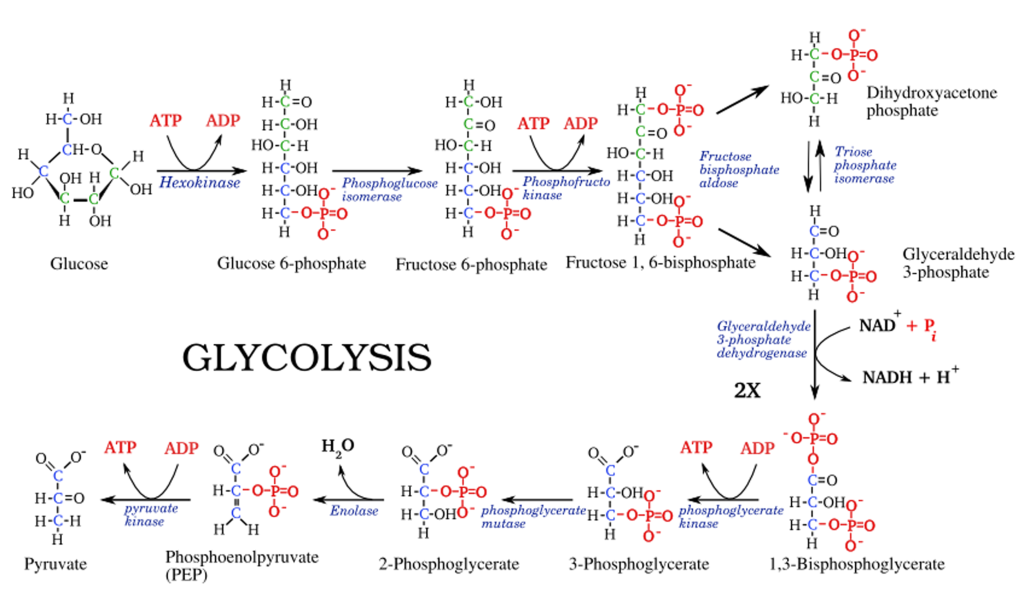Glycolysis is a crucial metabolic pathway found in all living cells, serving as the initial step in the breakdown of glucose to produce energy. This ancient and highly conserved process occurs in the cytoplasm and plays a central role in both aerobic and anaerobic respiration. In this note, we’ll delve into the details of glycolysis, exploring its steps, significance, and outcomes.
Key Steps of Glycolysis
Glycolysis comprises a series of ten enzyme-catalyzed reactions, which can be summarized as follows:
1. Glucose Phosphorylation: The process begins with the phosphorylation of glucose, converting it into glucose-6-phosphate. This step requires the input of two ATP molecules.
2. Isomerization: Glucose-6-phosphate is converted into its isomer, fructose-6-phosphate.
3. Phosphorylation: Fructose-6-phosphate is phosphorylated once again, becoming fructose-1,6-bisphosphate, thanks to the input of another ATP molecule.
4. Cleavage: Fructose-1,6-bisphosphate is cleaved into two three-carbon molecules, dihydroxyacetone phosphate (DHAP) and glyceraldehyde-3-phosphate (G3P).
5. Isomerization: DHAP is isomerized into another molecule of G3P.
6. Oxidation and Phosphorylation: In this step, each G3P molecule is oxidized while simultaneously transferring a phosphate group to NAD+ to form NADH. Additionally, ADP is phosphorylated to produce ATP.
7. Substrate-Level Phosphorylation: The high-energy phosphate group from G3P is transferred to ADP to yield another ATP molecule. This step occurs twice for each glucose molecule.
8. Isomerization: One of the G3P molecules is converted into the other isomer, resulting in two identical three-carbon molecules.
9. Phosphorylation: Both three-carbon molecules are then phosphorylated, forming 3-phosphoglycerate.
10. ATP Production: Phosphoenolpyruvate (PEP) is generated by further phosphate transfer and is used to produce ATP via substrate-level phosphorylation. This step also occurs twice per glucose molecule.
Outcomes of Glycolysis
Glycolysis has several significant outcomes:
1. ATP Production: Glycolysis generates a net gain of two ATP molecules per glucose molecule through substrate-level phosphorylation.
2. NADH Production: Two NADH molecules are produced for each glucose molecule as a result of the redox reactions in glycolysis. These NADH molecules are crucial for later stages of cellular respiration.
3. Pyruvate Formation: The final product of glycolysis is two molecules of pyruvate, each containing three carbons. Pyruvate serves as a key substrate for further stages of cellular respiration, particularly in aerobic respiration.
4. Energy-Rich Molecules: The energy stored in glucose is partially captured in the form of high-energy phosphate compounds, ATP, and NADH.
Significance of Glycolysis
Glycolysis holds several vital roles in cellular metabolism:
1. Energy Production: It provides a rapid means of generating ATP, which can be used to meet immediate energy demands of the cell.
2. Universal Pathway: Glycolysis is universally conserved in all living organisms, making it an ancient and essential metabolic pathway.
3. Anaerobic Respiration: Glycolysis can occur in the absence of oxygen, allowing cells to produce ATP under anaerobic conditions. It’s a crucial pathway during activities like strenuous exercise.
4. Metabolic Regulation: Glycolysis is subject to regulation by various factors, including feedback inhibition and hormonal control, ensuring that energy production is balanced and responsive to the cell’s needs.
Glycolysis serves as the cornerstone of cellular energy production, initiating the breakdown of glucose to produce ATP and other energy-rich molecules. Its simplicity, conservation across species, and ability to operate in diverse environmental conditions make it a fundamental and fascinating process in the realm of cellular metabolism. Glycolysis provides the necessary energy and substrates for further stages of respiration, highlighting its importance in the overall energy balance of living organisms.





Leave a Reply
You must be logged in to post a comment.